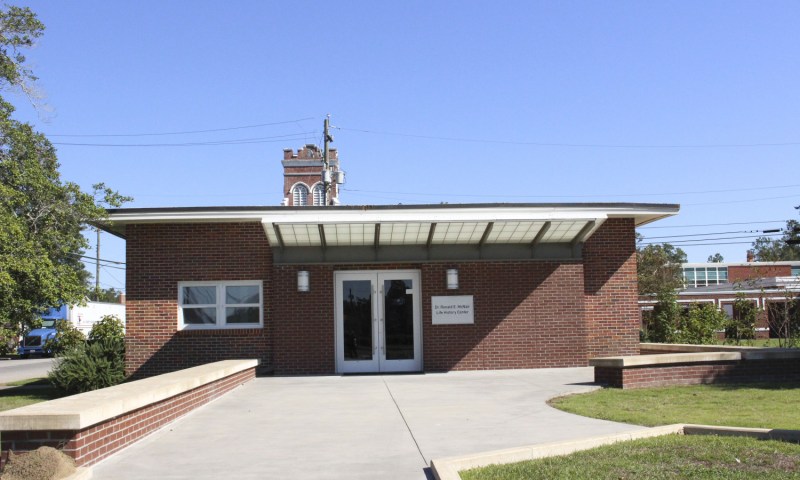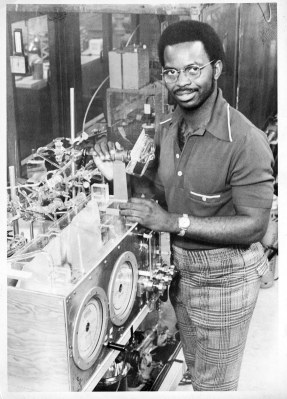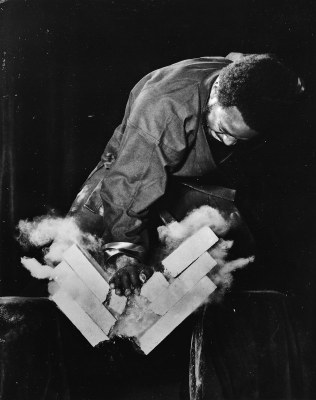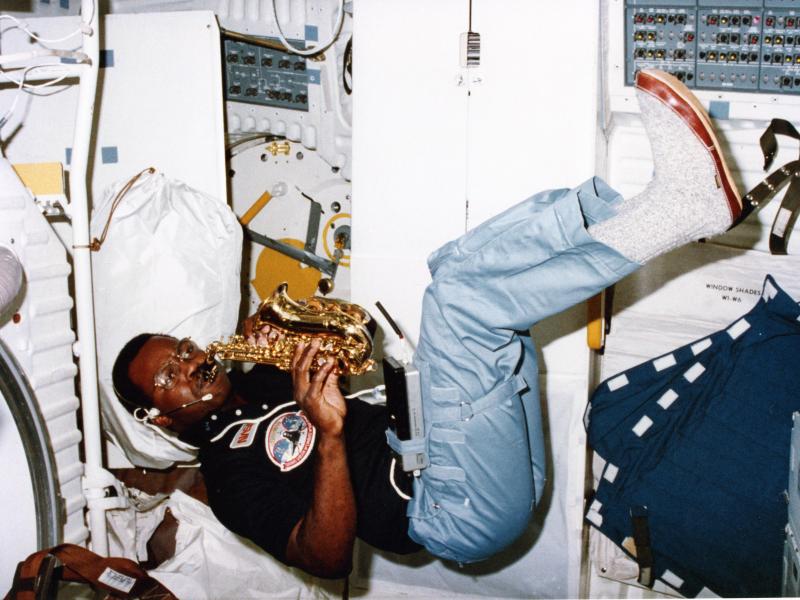There is more than one way to lead a successful life. Some people have all the opportunity in the world laid out before them, and it never does them any good. Others have little more than the determination and desire they’ve dredged up within themselves, and that grit turns out to be the abrasive that smooths the path ahead.
Ronald McNair succeeded despite poverty, racism, and an education system designed to keep Black people down. He became an accidental revolutionary at the age of nine, when he broke the color barrier in his small South Carolina town via the public library. This act of defiance in pursuit of education would set the course for his relatively short but full life, which culminated in his career as a Space Shuttle mission specialist.
Rule-Breaker with a Slide Rule
Ronald McNair was born October 21, 1950 in Lake City, South Carolina, the second of three sons, to Pearl and Carl McNair. His mother was a teacher, and encouraged his love of reading. Ronald’s father, Carl was an auto mechanic who never finished high school and always regretted it. Though the family was poor, Ron grew up surrounded by books, music, and support.
Ronald learned to read by the time he was three years old, and his father forged his birth certificate so he could start school at age four. From a young age, he was obsessed with science fiction, space, and Sputnik in particular. Even though the house was filled with books, there was one book that Ron didn’t have: the one that told him much more about his prized slide rule than the pamphlet that came with it.

In the summer of 1959 he located the book in the Lake City public library. There was only one problem: the library was segregated, and he wasn’t allowed check it out. Nine-year-old Ron didn’t abide, so he simply refused to leave the library until they let him check out his stack of books. First the librarians called the cops, and then they called his mother.
Pearl McNair arrived to find her son sitting on the checkout counter, his little legs dangling down the side. Since he wasn’t causing any real trouble, she proudly stood by her son in the matter, telling the librarians that they ought to just let him check out the books. From that day on, Ron could check out books whenever he wanted.
Ronald was determined in every aspect of his life, and his well-rounded personality is like something out of fiction. Throughout school, he was serious about his studies to the point of being competitive. Ron competed with his friends for the best grades, and won most of the time. In high school, Ron played baseball, football, basketball, and ran track. He also excelled in music, starting on the clarinet and settling on the saxophone. In spite of all these talents and obligations, Ron still found time to be social and was well-liked. To the surprise of probably no one, Ron graduated as class valedictorian.

A Laser Focus
Lake City stood firmly in the segregated South, but inequality wasn’t something Ron focused on. Still, it affected him. He couldn’t just apply to whatever college he wanted, no matter how good his grades were. And even though Ron had excellent and supportive high school teachers, the “separate but equal” doctrine meant that his education was not as robust or varied as that of white students.
After high school, Ron got a scholarship to the closest college that offered physics to Black students — North Carolina Agricultural and Technical State University in Greensboro. He entered as a music major, but after speaking with a guidance counselor, he switched to physics.
Ronald had to work particularly hard because of the gaps in his underfunded education. But he still found time to be well-rounded. Freshman year he started learning Tae Kwon Do, eventually becoming a fifth-degree black belt and a teacher.
Ron went to MIT for two semesters as part of an exchange program that was designed to get students of color to pursue the sciences. Once he earned his bachelor’s degree in physics from North Carolina A&T, Ronald returned to MIT for his graduate degree. He had to study harder than ever, and confront racism head on at the same time. Ron had a couple of bad experiences in Cambridge. Once he was pursued by a group of men and jumped by one of them. Another time, someone sicced their dog on him.

The Physics of Tae Kwon Do
At MIT, Ron focused his doctoral thesis on laser physics. He helped make some of the first chemical and high-pressure carbon dioxide lasers in the MIT physics lab. He failed his first attempt at the five-hour long PhD exam. Then, he lost a notebook with two years of notes in it. He had to redo all of his lab work, but ended up with even better notes the second time and passed the exam.
Around the time he co-wrote an article for Scientific American about the physics of tae kwon do (PDF), Ron met his future wife, Cheryl at a church potluck, and they got married after graduation. Ron got a job as a staff physicist at Hughes Research Laboratories, a center for advanced laser research in Malibu, California. One of his duties was laser research for communication between satellites.
The following year, Ron got a targeted brochure in the mail from NASA, who were looking for mission specialist candidates. He gleefully applied, encouraged by Cheryl. Ron and 34 other people were accepted from a pool of 10,000 applicants.
Space Saxophonist
Ron spent six years in astronaut training before his first mission on the Space Shuttle Challenger. In the meantime, he and Cheryl had two children, Reginald and Joy. At the end of his training, Ron was assigned to the orbiter’s fourth mission, STS-41-B, which launched on February 3rd, 1984. The mission included the first-ever untethered spacewalk, and Ron made history as the second African-American in space.
The mission’s main objectives were putting a pair of satellites into orbit and testing new equipment. For his part, Ron was assigned to do experiments with solar cells and pneumatic conveyors, operate a gas spectrometer focused on the orbiter, and use the remote sensing camera to take pictures of Earth. He was also in charge of operating the new 50-foot mechanical arm that was designed to snatch satellites and bring them in for repair. Ron had another, secret objective: playing the saxophone in space. In the months leading up to liftoff, he had several discussions with a music store owner to research how space jazz might work. He sneaked a soprano saxophone on board and blew a solo rendition of “What the World Needs Now is Love”. As far as anyone knows, Ron McNair was the first person to play a saxophone in space.

Ron received quite the reception when he returned to Lake City. There were celebrations, parades, and a street renaming in his honor. Most notably, Ron’s boot prints were set in concrete at a park that once forbade Black people. He gave talks at MIT and elsewhere, always making sure that young students, especially of color, were invited to them.
Two years later, Ron was scheduled to return to space on the ill-fated Challenger mission in 1986. He was planning to record a sax solo for a Jean-Michel Jarre album on the shuttle, having proven the viability of the instrument away from Earth. He lost his life along with six other crew members when the shuttle broke apart during launch the morning of January 28th, 1986.
Since the tragedy, many buildings and schools have been named in the honor of the seven men and women whose lives were cut short that cold January morning. MIT dedicated the building that houses the Center for Space Research after Ron. In 2011, the Lake City library was rebuilt, and the original building was turned into the Ronald E. McNair Life History Center. Anywhere a kid can be found trying to rise above their circumstances, Ron’s spirit lives on.
















Damn. Heck of a story about a heck of a man…and the power of access to a library.
We lost a good one. Ad astra.
Yep we lost a good one but he’s blowin’ sax in the sky now.
There’s three times as many hardcore-awesomeness photos of him on this page alone than I have from my entire life. Playing a bent soprano sax while weightless? Busting bricks in a black dobok? Oh, and when he’s not just doing it for fun you’ll find him kickin’ the tires on some lasers in the MIT physics lab.
His Ph.D. in Physics was declared in what year?
(I was trying to follow the timeline of his life in the article, but didn’t see any mention of that)
1976.
space jazz is almost as good as snake-jazz :)
Just when I think my life’s been hard… here’s someone that blows my experiences out of the water… good and bad. Truly impressed with his story and naturally saddened by his story’s end.
This was an amazing article I deeply enjoyed reading.
This is what a scientific badass looks like.
What an awesome story, to overcome that, and protest segregation by checking out library books on math. So poetic.
This is s person who makes me proud to be American, when very few do anymore. And space jazz tae kwon do combo just throws it literally past the stratosphere.
How have I never heard of him till now? America does too much to promote horrible vacuous idiots and not enough to promote awesome people like this
+1
+1
Of course I’d heard of him from the Challenger loss, but I share the believe we should hear more about the positives of people rather than the news being so full the negative. I think people learn by example and the media is full of the wrong kind of example.
+1 +1
great article, totally inspiring. Great to see capitalized Black, about time.
I noticed that, and wondered “why?”.
I don’t see any reason to capitalize “white” when describing me.
Awesome, inspiring and touching reading! Thanks for the article.
If I were the kind of guy who had heroes, that dude would be way up the list.
What a great guy and moving story. And so sad. I always wanted to learn more about him since I first heard “Ron’s Piece” on the Jean-Michel Jarre “Live in Houston” cassette tape in 1987 – Jarres announcment “I’d like to dedicate this next song to my friend, the astronaut Ron McNair” was also one the cassette tape:
https://www.youtube.com/watch?v=eIRAmDomoAA
Back then, we didn’t have the internet, and I largely forgot about it. Great to be reminded of him and be able to read up on his life history. Rest in piece, Ron – with the stars and a saxophone.
This is a great story. I didn’t know much about Ron McNair except that he was going to play the Sax on a Jean Michel Jarre track on the Album Rendezvous – I understood the original concert date had been set for when he was actually in orbit and he’d play live.
But it turns out he was a very impressive polymath, Christian and possibly martial arts expert too.
Working in the UK scientific reseach world when Challenger failed, I was aware of the crew, but as a JMJ fan I was also very much looking forward to the live link up between Jean and Ron for “Rendezvous”. It was a very sad day.
This article adds the backstory that should be an inspiration to young people of all colours, proving that hard work and persistence can overcome prejudice in all scenarios.
RIP Ron, let the stars shine a little brighter tonight for you.
No, not necessarily in “all scenarios”.
“someone sicced their dog on him.” I had to translate that into English. Another American word learnt.
I had the same thought, if it wasn’t for Ron’s truly remarkable life, I may not have ever known the proper spelling, so you see, his life touched me personally even if it was simply a word used by the author describing a low moment, had it not been part if his life, I probably would not have ran accross the proper spelling, ie. Always though it was slang and spelled ”sicked”.
In our Baha’i community we celebrate Ron McNair as the first Baha’i in space. http://www.uplifitingwords.org says this of his faith: McNair first encountered the Baha’i Faith as a very young person in the early 1960s in his hometown of Lake City, SC, through spiritual education classes taught by two local women, Genelle Grimsley and Clarice Stevens. He maintained his Baha’i membership until the end of his life. Friends noted that he took fellow-astronauts to a Baha’i meeting the night before the fatal flight, and that he had his book of Baha’i prayers with him when the Challenger exploded.
While I had heard the Challenger names before, I didn’t really remember or know about this guy until I moved to Lake City. He is truly an inspiration and the racism he faced is still palpable here decades later. If you pan to the right of that library picture you would see the awesome memorial statue built to him.
https://www.thestate.com/latest-news/8pems5/picture14164529/alternates/FREE_1140/mcnair_GM001.source.prod_affiliate.74.JPG